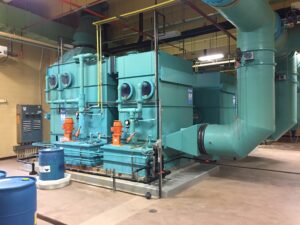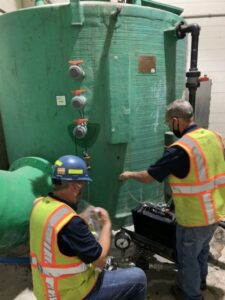Odor Control Treatments by Facility Type: Customizing Treatments for Industrial, Municipal, and Agricultural Sites
 At Webster Environmental Associates, we understand that no two odor problems are the same. The conditions at a municipal treatment plant differ from those at a food processor or composting site. That’s why our approach to odor control treatments begins with a detailed understanding of each facility’s layout, emissions, and operating challenges. We don’t rely on one-size-fits-all systems. Instead, we design odor control strategies that work in the real world—no matter the setting.
At Webster Environmental Associates, we understand that no two odor problems are the same. The conditions at a municipal treatment plant differ from those at a food processor or composting site. That’s why our approach to odor control treatments begins with a detailed understanding of each facility’s layout, emissions, and operating challenges. We don’t rely on one-size-fits-all systems. Instead, we design odor control strategies that work in the real world—no matter the setting.
Municipal Wastewater Plants: Balancing Regulations and Community Pressure
Municipal wastewater facilities face constant pressure to stay compliant and avoid odor complaints from nearby neighborhoods. Many of the strongest odors come from:
- Headworks and grit removal systems
- Primary clarifiers and settling tanks
- Sludge handling and digestion areas
We often recommend a mix of physical and chemical treatments for these sites. Liquid-phase treatment, including the use of magnesium hydroxide, can help neutralize odors directly in the wastewater stream. We combine this with physical containment systems, such as custom covers, to prevent odor migration.
In many cases, we also install biofilters or biotrickling filters to treat captured air before it’s released. Our team works with municipalities to balance cost, performance, and long-term reliability.
Industrial Manufacturing Sites: Handling Complex Chemical Emissions
Industrial facilities present a different kind of challenge. The odors in these environments often come from volatile organic compounds (VOCs), solvents, or other reactive chemicals. These emissions can vary throughout the day and may require more robust treatment systems.
For these applications, we typically use high-performance chemical scrubbers or thermal oxidation systems. Scrubbers use liquid solutions to remove contaminants from the air, while thermal oxidizers destroy compounds through high heat. Before selecting a solution, we conduct airflow measurements and emissions profiling to understand the full scope of the problem.
Industrial odor control also involves meeting strict safety and regulatory standards. We help clients meet state and federal requirements while improving indoor and outdoor air quality. Our team stays involved through design, permitting, and post-installation testing.
Agricultural and Organic Waste Operations: Biological Odors and Weather Factors
Facilities that manage organic waste face unique challenges. These include composting operations, manure treatment systems, and food waste digesters. Odors from these sites are often caused by the breakdown of organic matter, which can produce sulfur-based compounds and ammonia.
Outdoor systems are especially sensitive to weather. Heat and wind can spread odors quickly, while heavy rains can change how emissions behave. We help agricultural clients manage these variables by using:
- Partial and full covers over active compost or waste piles
- Misting systems with neutralizing agents
- Mist scrubbers for airflow captured from enclosed zones
Seasonal odor spikes are a common issue in these environments. Our team works with operators to adjust treatment systems as conditions change.
Technology Matching: WEA’s Treatment Toolbox
 Our success comes from having a broad range of odor control technologies available. We match each facility’s needs with the most effective solution or combination of solutions. Our odor control tools include:
Our success comes from having a broad range of odor control technologies available. We match each facility’s needs with the most effective solution or combination of solutions. Our odor control tools include:
- Chemical scrubbers
- Biofilters and biotrickling filters
- Activated carbon units
- Thermal oxidation systems
- Covers, enclosures, and ducting
Each project begins with a thorough evaluation. We look at emissions data, air flow patterns, and physical space to recommend the right configuration. This allows us to design efficient, scalable systems that are built to perform.
WEA’s Site-Specific Approach
We start with a field evaluation to understand your specific odor sources and how they behave. Using site visits, sampling, and modeling, we pinpoint where emissions originate and how they move. From there, we provide:
- Odor tracking and baseline data collection
- System modeling to test treatment performance
- Full design packages, including layout and equipment sizing
- Support for permitting and regulatory approvals
- Long-term service, maintenance planning, and performance testing
Our engineering team works closely with operators and maintenance staff. We adapt each design to the day-to-day realities of the facility, making it easier to operate and maintain over time.
Build the Right Odor Control Treatment Strategy with WEA
Odor problems don’t all follow the same script. Each site has its own challenges, from chemical complexity to weather exposure or regulatory pressure. That’s why targeted odor control treatments are so important. At WEA, we design and install systems that match the unique needs of industrial, municipal, and agricultural facilities.
Whether your site handles wastewater, chemicals, or organic waste, our team will help you find the right combination of technologies. Contact Webster Environmental Associates to schedule a site evaluation or discuss your odor control goals. We’re here to help you protect your operation, your workers, and your community.
